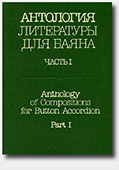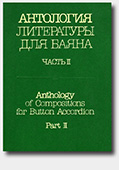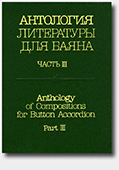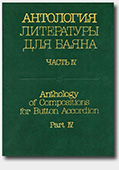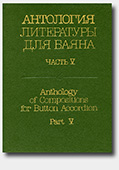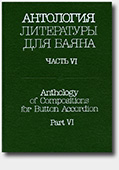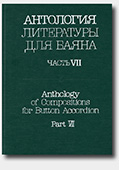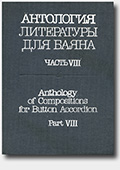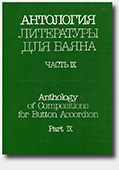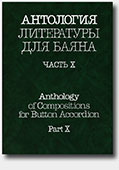*** FOREWORD to this edition ***
Anthology of Compositions for Button Accordion. Part I
Anthologie des compositions pour l'accordéon bouton. Partie I
Language: Russian-English
Number of pages: 126
 Here's zipped demo in JPG format
Here's zipped demo in JPG format
Difficulty level: Beginner - Intermediate - Advanced
Bass: STANDARD
Content:
Feodosy RUBTSOV. Concerto No. 1 for Button Accordion and Orchestra of Russian Folk Instruments.
Arranged for Button Accordion and Piano ![]()
Ivan Panitsky. Variations on the Russian Folk Song Polosynka ("My Patch of Land")
![]()
Oy Da Ty, Kalinushka ("Hey You Nice Little Guelder Rose"). Arranged by I.Panitsky![]()
Ivan Panitsky. Variations on the Russian Folk Songs Sredi Doliny Rovniya
("Amidst the Dale So Wide and Even") and Svetit Mesyats ("Shines the Moon")
![]()
Ivan Panitsky. Variations on the Russian Folk Songs
Akh Vy, Druzhki ("Hey You Fellows") and
Uzh Kak Po Mostu-Mstochku ("Once Along the Bridge, That Little One")
![]()
Ivan Panitsky. Variations on the Russian Folk Songs
Nochenka ("Pitch-Dark Night") and
Vo Sadu Li, V Ogorode ("In the Garden, in the Yard")
Ivan Panitsky. Variations on the Russian Folk Songs
Vot Mchitskya Troyka Pochtovaya
("A Three-Hoarsed Post Coach Speeding Onward") and Kak Pod Yablonkoy ("Once Beneath That Apple-Tree)
![]()
Yablochko ("Little Apple"). Russian Folk Dance. Arraged for Accordion SOLO by Alexandr DANILOV
![]()
(available for Accordion DUO here)
*Price: 25 И
how to order
need advise?
Sheet music from the series "Anthology of Compositions for Button Accordion"
for Accordion / Bayan / Accordeon / Akkordeon /
Fisarmonica / Harmonika / Harmonica / Trekkspill / Dragspel / Harmonikka /
Bajan / Akordeon:
|
Video demo: F.Rubtsov. Concerto No. 1 - Final.
Performed by Yury Shishkin, accordion (bayan) |
|
Video demo: Ivan Panitsky. Variations on the Russian Folk Song "Polosynka". Performed by Vladimir Grachev, accordion (bayan)
Video demo: Ivan Panitsky. "Oy Da Ty, Kalinushka". Performed by Sergey Naiko, accordion (bayan)
Video demo:
Ivan Panitsky. Variations on Russian Folk Songs "Sredi Doliny Rovniya" and "Svetit Mesyats".
Performed by Mikhail Ovchinnikov, accordion (bayan)
Video demo: Ivan Panitsky. Variations on the Russian Folk Songs "Akh Vy, Druzhki" and "Uzh Kak Po Mostu-Mstochku". Performed by Sergey Fukalov, accordion
Video demo: Ivan Panitsky. Variations on the Russian Folk Songs "Vot Mchitskya Troyka Pochtovaya" and "Kak Pod Yablonkoy". Performed by Yury Sidorov, accordion (bayan)
Video demo: Yablochko. Russian Folk Dance. Arraged by Alexandr DANILOV.
Performed by bayan trio: A.Kuznetsov, Ya.Popkov, A.Danilov
(Attention! The piece in this book is for Bayan / Accordion SOLO)
| to the top |
FOREWORD to 1984 year Anthology I edition
-----
Russian folk instruments have a special significance in the history of this country's
music culture. Widely popular with the masses, bayan, balalaika and domra are
indispensable components of today's professional music scene.
Exceptionally great advances have been made by the Russian-type button-key accordion,
commonly known here in the USSR as bayan
* .
Its predecessor, traceable back to the
early 19th century, was a pimple, unpretentious squeeze-box; the modern multitimbre
instrument, which gives the player the alternative of utilizing ready-made chords
or of applying uncon-fined l.h. patterns, allows of solving most complicated aesthetic
and technical problems.
Although the Russian button accordion has been in existence for about a hundred
and fifty years, it was only by the end of the twenties that the players began to
acquire professional training. Since then, the art of playing the instrument has
grown to such an extent that the present-day standard is truly incomparable to
that of fifty years ago.
The best of our young accordion players regularly participate in international performers'
competitions, and, as a rule, win prizes. Our leading concert accordionists, in
a level with other instrumentalists, go touring throughout the country and abroad,
and are fervently applauded by the public.
The progress of the art of playing the button accordion was accompanied by the
development of didactic thought, with theoretical contributions by distinguished
Soviet experts in the field determining the methodology of training. There appeared
numerous methods, self-instruction manuals, and scholarly papers on various aspects
of teaching and performing. The growing proficiency in playing the Russian-type
accordion has had much bearing on the development of the instrument itself.
These important factors could not but result in the accumulation of the repertoire
and, particularly, in the advancement of creating original pieces of music to be
played on the button accordion. Every stage in the process of improving the instrument
gave rise to new aesthetics and techniques of composition, new expressive devices,
new features of musical language. During the decades past, a voluminous repertoire
has been built up, with a considerable amount of compositions in various forms
showing exquisite artistic merits.
First attempts to create an original repertoire date back to the thirties. Yet the
pieces by V. Zarnov, F. Klimentov, V. Rozhkov, let alone the amateurish arrangements
of folk songs, could never satisfy the musicians' growing requirements. To reveal
the expressive resources of the Russian button accordion, performers were in need
of sophisticated large-scale works and unaffected folkloresque miniatures.
In the mid-thirties I. Panitsky, an outstanding autodidact from Saratov, became
one of the best arrangers of folk songs. Working on the basis of an intimate knowledge
of Russian musical folklore, he managed to reproduce its peculiarities in a very
careful and delicate way. In his arrangements of lyrical "drawn-out" songs, the
musician has truthfully reflected their substantial qualities, such as flexibility,
plasticity and unhurriedness of continuation, metrical freedom, asymmetric phrase-building.
The Akh, vy, druzhki arrangement can serve as a vivid example of that. I. Panitsky
has also succeded in preserving the textural properties of traditional part-singing
as practised in the midst of the countryfolk from ancient times up to now; reference
may be made to the expressive "solo" introduction giving way to the "choral" refrain
in his arrangements of the songs Oy da ty, kalinushka and Luchinushka.
Just the other way about, I. Panitsky's arrangements of Russian dance-style songs
show the specific manner of music-making characteristic of the dextrous rural squeeze-box
players, with their infinite inventiveness in varying the initial tune in line with
the increasing excitement of the dancers.
It is worth noting that I. Panitsky has artistically made use of a distinctive
dual form, which, in Academician B. Asafyev's words, represents "a typically Russian
juxtaposition of a drawn-out song and a dance-style one."
1
This principle of form-building, introduced into the realm of symphonic writing by Mikhail Glinka in his brilliant
Kamarinskaya, has proved to be in perfect harmony with the very nature of the bayan,
which is equally appropriate to melodious tunes and to rhythmicized strains.
The procedure of fusing the two types of songs Ч "drawn-out" and dance-style Ч has
been uniquely exemplified by I. Panitsky. Their specific idioms either mix in "intermediate"
variations (see, e. g., the third entry of the Nochenka theme, with insertions of
the Vo sadu It, v ogorode) or contrast with each other due to textural and modal
factors (e. g., the juxtaposition of variant Ч major / minor Ч keys at the entry
of the Kak pod yablonkoy theme after the variations on the Vot mchitsya troyka pochtovaya
or the juxtaposition of related keys by placing side by side the songs Akh, vy,
druzhki and Uzh kak...).
A second direction in developing the button accordion repertoire is creating original
large compositions. The earliest remarkable instance of that sort is the First
Concerto for button accordion and Russian folk instruments orchestra (1937) by
F. Rubtsov (Leningrad), who has made himself a name as a student of folk music.
This two-movement composition may be regarded as another example of employinig
the structural principle of duality referred to above (in a larger format, and in
a genuinely symphonic context): the first movement is based on the idioms of lyrical
folk songs; the second, on those of dance-style songs. In his Concerto, the composer
managed to comprehensively demonstrate potentials of the ready-chord instrument
which were far from being obvious in those days.
2
These potentials manifest themselves,
inter alia, in rather a dense, close texture (see, e. g., 1st movement, ref. nos
11, 17), in the melodization of the l.h. part (2nd movement, ref. nos 16Ч20), and
in the employment of a glissando encompassing the diminished seventh chord.
3
In the mid-fourties and early fifties, compositions by N. Chaikin, A. Kholminov,
and Yu. Shishakov were in the highlight; these composers displayed communicativeness
of expression, diversity and sincerity of the emotions expressed. It is to be noted
that N. Chaikin tends towards the traditions of romanticism, whereas in Yu. Shishakov
and A. Kholminov one can perceive a certain influence of "The Five". Their accordion
works are indicative of their desire to exploit to the utmost the resources of the
ready-chord 1. h. keyboard with a view of searching for new means of expression.
Thus, it is only natural that the best of the compositions written by the mentioned
musicians in those years, such as Sonata No. 1 and Concerto No. 1 by N. Chaikin,
Suite by A. Kholminov, and Concerto by Yu. Shishakov, have constituted the cornerstone
of professional training, and retain their significance today.
The early sixties mark a new stage in the development of the button accordion repertoire.
Using the relatively limited means of the instrument with ready-made chords creatively,
composers had been consistently working for a better technical and artistic standard
of performers. The Concert Suite by N. Chaikin (1962) can be considered a turning-point,
for it was the first time a composer attempted to utilize the single-note-and-ready-chord
l.h. keyboard. The subsequent generations of composers have intended their accordion
works mainly for the modern-type instrument Ч the multitimbre single-note/ready-chord
button-key accordion.
As with other musical genres, composers of accordion music have been anxious to
overcome a certain academic slackness, i.e. the inertia of creative thought characteristic
of some previous works, so as to seek for new matters and manners.
Compositions by A. Repnikov dating from the sixties (Capriccio, Recitativo and Toccata
etc.) are noteworthy for youthful energy and vitality expressed by means of innovatory
idioms (dissonant sequences of seventh and ninth chords, intricate rhythmic patterns,
peculiar accents, diversity in tonal organization).
The creative work of Vl. Zolotaryov can be described as a milestone of the utmost
importance for the incontestable progress of accordion music in the sixties and
seventies. In his Partita, his Second
and Third Sonatas, six suites for children,
and "Five compositions", the advantages of the new-type accordion have, as never
before, been wholly revealed. The instrument has become a full and equal participant
in the chamber sphere of art music.
The composer has entrusted the instrument with his most earnest and ambitious ideas,
his innermost thoughts and feelings. He has imparted to it a world of philosophy.
The button accordion repertoire has been enriched with elaborate compositions disclosing
a range of aesthetics unknown to the instrument before. In these pieces of music,
the obscure and tragic combines with the sublime and purifying; the tense dramaticism,
with an unassuming humour. Innovation in the field of aesthetics has called forth
a considerable advance in stylistics: for the first time in the history of Russian
accordion music use has been made of serial writing, the twelve-note technique,
various sonoristic devices (clusters and cluster-sliding on the keyboard, effects
caused by special ways of handling the bellowsЧtremolos of different kinds, ricochet,
vibrato, etc.). But the main thing about the works by Vl. Zolotaryov is their depth
and unmistakeable sincerity, which has secured their firm place in the repertoire
of accordionists.
Innovatory works by G. Banshchikov, S. Gubaidulina, A. Zhurbin, composed during
the past decade, have proved to be important contributions to the repertoire. Simultaneously,
folklore trends have been making themselves clearly discernible in the musical output
of the last years. On the one hand, there is a tendency towards a fuller apprehension
of the folk song traditions of various regions of the country; to put it differently,
composers endeavour to widen the geography of folk idioms capable of informing their
work. Here one can mention compositions by V. Zubitsky and V. Dovgan based on Carpathian
tunes, works by A. Kusyakov, which re-actualize traditional folklore of the Don
river area, etc. On the other hand, there is an active search deep into the history
of musical folklore, which has resulted in masterly revitalizations of archaic songs
Ч old-time lamentations, ritual tunes, etc. Compositions by K. Volkov Ч his two
sonatas and a concerto Ч are telling examples of this.
Aesthetically, the best of what has been written for accordion is in no way inferior
to the bulk of modern chamber music. The repertoire created by Soviet composers
during the half-century enjoys wide popularity in many countries of the world, where
the process of contextualizing the modern accordion has much in common with analogous
developments in this country. However, owing to the national peculiarities, the
accordion culture of each country bears its specific features. Soviet performers
appreciate accomplishments of foreign composers of accordion music, such as J. Hatrik,
V. Trojan (Czechoslovakia), G. Breme, G. Boll (GDR), T. Lundkvist (Sweden), O. Schmidt
(Denmark), and others.
Today, for all its being integrated into the realm of chamber music, the bayan remains
truly popular with the vast strata. That is why writing large concert works, ambitious
in content and form, should never be the only direction of the further development
of the accordion repertoire: it is no less needful to compose smaller pieces and
fantasies immediately reflecting folk songs and dances. In this respect, the traditions
of I. Panitsky have been successfully continued during the past two decades by
V. Podgorny, A. Timoshenko, G. Shenderyov a. o.
To publicize and widely popularize evergreens of button-key accordion music, the
Muzyka Publishing House has launched the series, "Anthology of Compositions for
Button Accordion", which is to comprise not only works of Soviet composers but also
music from Czechoslovakia, the German Democratic Republic, Sweden, Norway, Finland,
the Federal Republic of Germany, France, and other countries.
There is every reason to believe that a further integration of the compositions
presented in this series into the concert practice will be a powerful stimulus for
composers to create new masterpieces of music for the modern button accordion Ч
an instrument which is extremely rich in aesthetic and technical resources.
The first volume of the series contains compositions written by Soviet musicians
in the thirties. Here are biographical notes on the composers.
RUBTSOV, Feodosy Antonovich (b. 1904), expert in musical folklore, teacher, composer.
Professor, Candidate of Art Studies. Graduated from the class of M. O. Steinberg
(composition) at the Leningrad Conservatoire in 1931. Member of the USSR Com-posers'
Union since 1932. Vocal and choral compositions, music for Russian folk instruments
orchestra, numerous arrangements of Russian folk songs. Papers on Russian folk music.
His Concerto No. 1 (1937) is virtually the first large-scale piece of art music
in the history of the Russian button accordion. Its musical language is based on
the traditions of Russian folk music. The multifarious utilization of potentialities
of the ready-chord 1. h. keyboard in this work was an important step in the development
of the instrument.
Panitsky, Ivan Yakovlevich (b. 1906),
concert performer, teacher, arranger. National
Competition (folk instruments), Moscow, 1939 (1st prize). Honoured Artist of the
Russian Federation.
He is renowned for his pioneering activity as a high-class accordion player and
arranger whose art is deeply rooted in the traditions of squeeze-box music-making.
His arrangements of Russian folk songs date, for the most part, from the thirties.
DANILOV, Alexander Fyodorovich (1901-65), concert performer, arranger. Member of
the Button Accordion Trio of Radio Moscow (with A. I. Kuznetsov and Ya. F. Popkov).
He was a famous virtuoso versed in the art of improvisation. His arrangement of
the Russian folk song Yablochko for three accordions is still greatly appreciated
by performers. The present publication includes a solo version of that arrangement.
Tr.: Ye. Khazanov, V. Yerokhin
* The term, derived from the name of an Old Russian rhapsodist, has been used in
reference to the accordion since the first decade of the 20th century. Be sure to
stress the second syllable: /bayaan/, i.e., in international phonetic symbols,
[bə'ja:n]. Ч V. Y.
[back to reading]
1
See: B. Asafyev (Igor Glebov), Glinka. Ч In: The Soviet Encyclopedia, vol. 17. Moscow, 1930, p. 228 (Russ.)
[back to reading]
2
As far as the idea of a single-note l.h. keyboard is concerned, it should be
borne in mind that in the thirties accordions with such a keyboard had not yet made
their way in musical life, though almost simultaneously with the Concerto by F.
Rubtsov there appeared a large composition for all-single-note accordion and symphony
orchestra Ч Concerto by T. Sotnikov, which, however, has left no considerable
trace in the history of accordion-playing.
[back to reading]
3
The present edition gives preference to the modern way
of executing the tremolo, viz. with the bellows, Ч instead of the
finger tremolando as presupposed by the composer in the first
version of the Concerto (see reference number 25).
[back to reading]

.jpg)
